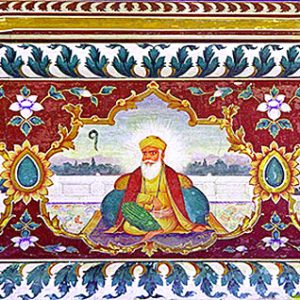
Temple in Goindwal, Punjab, India
Wikimedia Commons
I thought I’d stick with the full moon theme this week. In my last blog post, I suggested that encouraging kids to name the full moon each month was a great way to stay connected to both the earth and our ancestors. Today, I’ll talk about another full moon – Kartik Puranmashi. There’s a good chance you’ve never heard the term, but for millions of people around the world, it’s a major holiday.
Kartik Puranmashi is not really the name for a full moon, it simply means “the full moon day in the month of Kartik.” Kartik is a month in the Hindu calendar. Hindu calendars are notoriously confusing for Americans because there are so many of them, but they’ve been used in India for centuries. They can be solar (based on the sun) or lunisolar (based on both the moon and the sun). They can also be regional, which means different parts of India use slightly different calendars. There are almost always twelve months in a year, and the month names tend to be similar because they are all based on Sanskrit. But over the centuries, even those words began exhibiting variations in both pronunciation and spelling. Frankly our confusion seems at least a wee bit justified.
To make things easier, the Indian government created a standardized version of the calendar called the Indian National Calendar. According to that, Kartik is the 8th month of the year, falling at the end of October/beginning of November on our calendar. And November 17, 2013 was the full moon = Kartik Puranmashi! Many Hindus fast on the full moon days of each month, but Kartik Puranmashi is special because it is also the birthday celebration of Guru Nanak, the founder of Sikhism.
Guru Nanak was born in 1469. As a child, Nanak was apparently inspired by the first letter of the Persian and Arabic alphabet. It is written as a straight downward stroke, like the number 1, and for Nanak, it was symbolic of the unity or oneness of God. Many years later, as a young man, Nanak disappeared for three days. Upon his return, he announced that God was neither Hindu nor Muslim. God was simply God – shapeless, timeless, present in all creation, and infinitely powerful. Nanak also preached a message of equality – regardless of religion, color, age, gender, or social rank. In 1500, it was a message significantly ahead of its time. Nine gurus followed Nanak. Each one added to Nanak’s initial teachings and to the growth of the Sikh community. The final guru announced around 1700 that the Sikh community was now in the hands of their sacred text, the Guru Granth Sahib.
The Sikh religion consists of three main practices. The first two share many commonalities with all the world’s religions. First, one must share with those in need. Guru Nanak lived this principle by starting common kitchens that served free food to anyone who entered. Second, one must live honestly, always working toward a community of equality. The “five thieves” – lust, rage, greed, attachment, and ego – represent the major weaknesses found in all humans and should be avoided if at all possible. Third, one must meditate on God. It is through such meditation that one attains enlightenment, unity with God, and salvation.
Today, it is estimated that there are over 27 million Sikhs worldwide, and over 250,000 Sikhs in the U.S. They are most easily recognized by their turbans, worn by many Sikh men who are prohibited from cutting their hair. The turbans symbolize honor, piety, and courage. In August of 2012, an American white supremacist fatally shot six members of the Sikh community at a temple in Oak Creek, Wisconsin before shooting himself.
So how do Sikhs celebrate the birthday of Guru Nanak on Kartik Puranmashi? They often take turns reading the entire Guru Granth Sahib in a non-stop, 48-hour recitation. They chant, sing songs, recite poems, and decorate their temples (gurudwaras). Processions, led by local Sikh leaders, are held. Martial arts demonstrations are staged. Community lunches are offered, in true Guru Nanak fashion, and a special sweet pudding, called karah prashad, is often served. Quite simply, it’s one of the many festive birth-of-a-religious-leader holidays celebrated around the world – like Christmas, the birth of the Buddha, and the birth of Baha’u’llah.
Members of minority religions often experience discrimination and hostility. The religion, itself, doesn’t seem to matter much. What matters is that the religion is not dominant in the culture. Buddhists kill Muslims in Myanmar. Muslims kill Coptic Christians in Egypt. Violence still erupts from time to time between Protestants and Catholics in Northern Ireland. And conflicts between Shi’a and Sunni Muslims are regularly reported in the American media.
True religious tolerance will not exist without effort, and it’s difficult to be tolerant of things we don’t really understand. That understanding must start now, and it must start with our young people. Reading an article about Sikhism is a great place to begin, but it’s not enough. Search for children’s books on the Sikh faith and read one to your kids. Make a traditional, Indian, double-headed drum out of two Styrofoam cups or plastic containers. See if there is a Sikh community in your area and find out how you might participate. Listen to Sikh kirtan music on You Tube. Even the smallest gestures will teach our children that tolerance is something we actively practice on a daily basis. And what better time than a full moon birthday to begin.
A few links…
A beautiful post written by a 2nd grade teacher in WI responding to the tragedy in 2012 at Rethinking Schools
Recipes for the sweet pudding often served on Sikh holidays
News articles out of India on Guru Nanak’s Birthday
[…] And November 17, 2013 was the full moon = Kartik Puranmashi! Many Hindus fast on the full moon days … […]